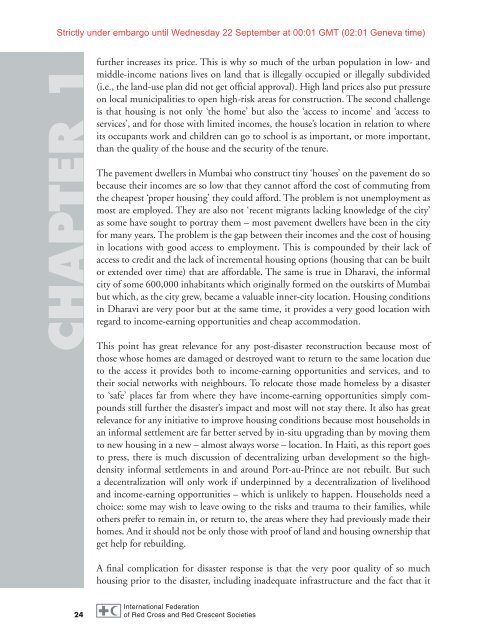chapter 4 - DRK
chapter 4 - DRK
chapter 4 - DRK
You also want an ePaper? Increase the reach of your titles
YUMPU automatically turns print PDFs into web optimized ePapers that Google loves.
Strictly under embargo until Wednesday 22 September at 00:01 GMT (02:01 Geneva time)24CHAPTER 1further increases its price. This is why so much of the urban population in low- andmiddle-income nations lives on land that is illegally occupied or illegally subdivided(i.e., the land-use plan did not get official approval). High land prices also put pressureon local municipalities to open high-risk areas for construction. The second challengeis that housing is not only ‘the home’ but also the ‘access to income’ and ‘access toservices’, and for those with limited incomes, the house’s location in relation to whereits occupants work and children can go to school is as important, or more important,than the quality of the house and the security of the tenure.The pavement dwellers in Mumbai who construct tiny ‘houses’ on the pavement do sobecause their incomes are so low that they cannot afford the cost of commuting fromthe cheapest ‘proper housing’ they could afford. The problem is not unemployment asmost are employed. They are also not ‘recent migrants lacking knowledge of the city’as some have sought to portray them – most pavement dwellers have been in the cityfor many years. The problem is the gap between their incomes and the cost of housingin locations with good access to employment. This is compounded by their lack ofaccess to credit and the lack of incremental housing options (housing that can be builtor extended over time) that are affordable. The same is true in Dharavi, the informalcity of some 600,000 inhabitants which originally formed on the outskirts of Mumbaibut which, as the city grew, became a valuable inner-city location. Housing conditionsin Dharavi are very poor but at the same time, it provides a very good location withregard to income-earning opportunities and cheap accommodation.This point has great relevance for any post-disaster reconstruction because most ofthose whose homes are damaged or destroyed want to return to the same location dueto the access it provides both to income-earning opportunities and services, and totheir social networks with neighbours. To relocate those made homeless by a disasterto ‘safe’ places far from where they have income-earning opportunities simply compoundsstill further the disaster’s impact and most will not stay there. It also has greatrelevance for any initiative to improve housing conditions because most households inan informal settlement are far better served by in-situ upgrading than by moving themto new housing in a new – almost always worse – location. In Haiti, as this report goesto press, there is much discussion of decentralizing urban development so the highdensityinformal settlements in and around Port-au-Prince are not rebuilt. But sucha decentralization will only work if underpinned by a decentralization of livelihoodand income-earning opportunities – which is unlikely to happen. Households need achoice: some may wish to leave owing to the risks and trauma to their families, whileothers prefer to remain in, or return to, the areas where they had previously made theirhomes. And it should not be only those with proof of land and housing ownership thatget help for rebuilding.A final complication for disaster response is that the very poor quality of so muchhousing prior to the disaster, including inadequate infrastructure and the fact that it
















